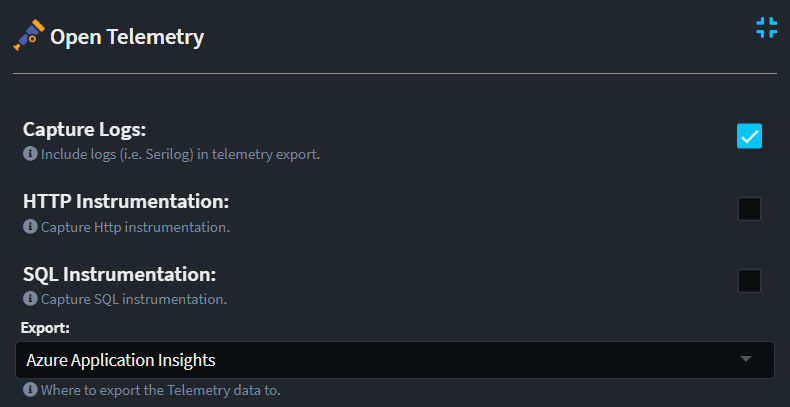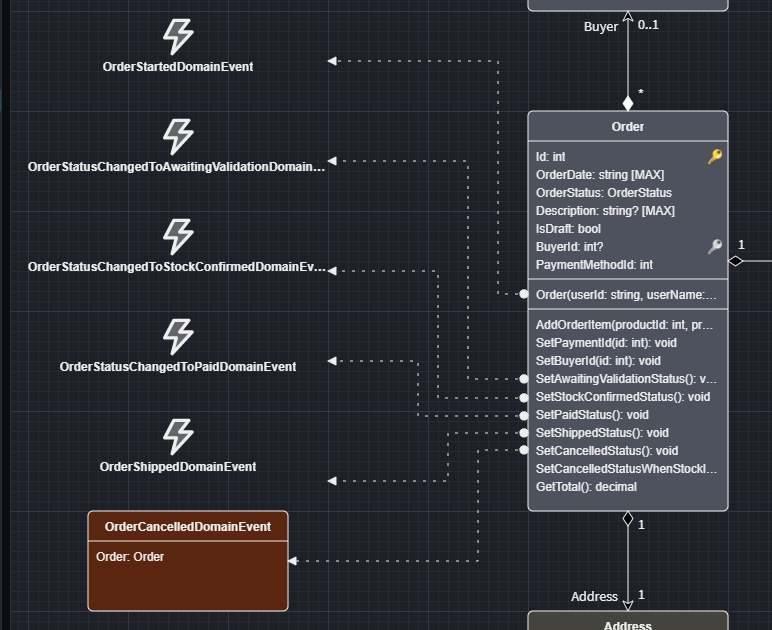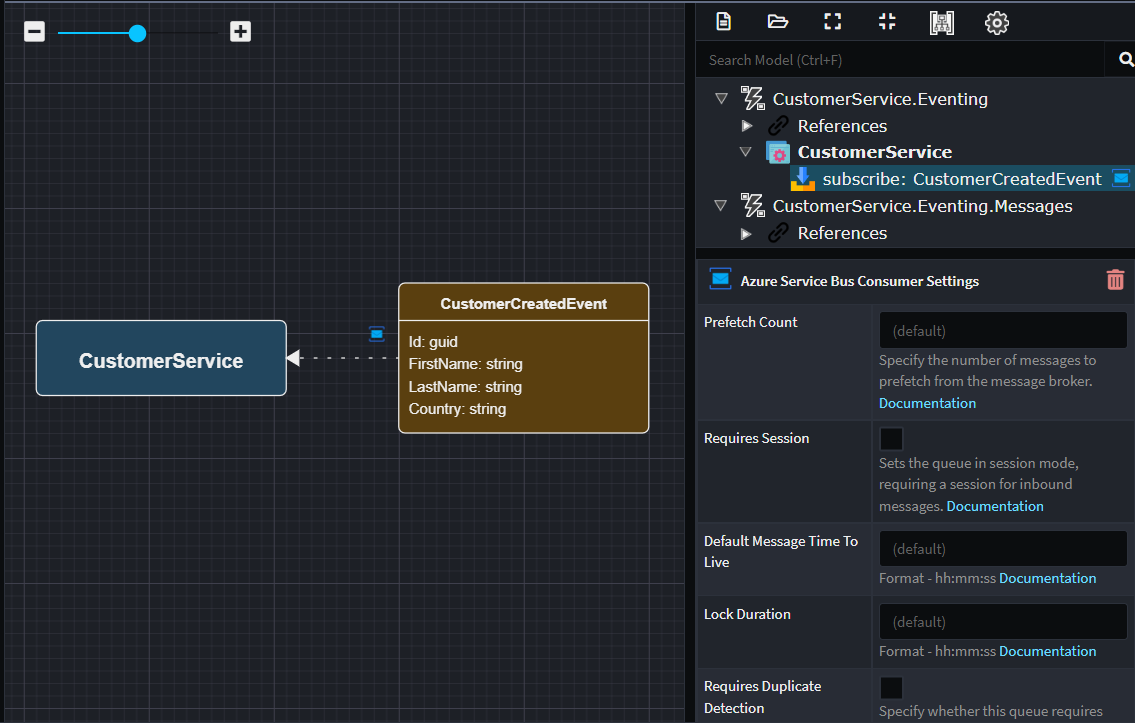What's new in Intent Architect (June 2023)
Welcome to the June 2023 edition of highlights of What's New in Intent Architect.
Product updates
- JSON document database domain importer tool now available - A CLI tool is now available for importing object graphs from JSON files into the Domain Designer for document databases (Cosmos DB, MongoDB, etc).
- C# RoslynWeaver sanitizer tool now available - A CLI tool is now available which can be used during a "release build" process to remove all Intent code management attributes and NuGet package dependencies from a Visual Studio solution if required by an organisation's policy.
- Hyperlinks inside designers will now open in your operating system's default browser - Instead of opening these inside a new "Intent Architect" window, these are now opened in your operating system's default browser.
Documentation updates
- New application building tutorials - Added two new tutorials to assist users in becoming better acquainted with application building.
Module updates (general)
- "New Enum" option now also available on the Domain diagram context menu - This context menu option is now also available when right-clicking a Domain diagram whereas before it was only available when right-clicking the tree view.
Module updates (C#)
- ASP.NET API Versioning support - Support for using the ASP.NET API Versioning NuGet package(s) for easily adding versioning to WebApi endpoints.
- Improved integration with Open Telemetry and API Responses for HTTP 500 errors - Configures ASP.NET Core to integrate more deeply with Open Telemetry which is an open framework for collecting and exporting telemetry data in order to observe how your system behaves in real time.
- New
NotFoundExceptionwhich maps to a 404 HTTP response for ASP.NET Core and Azure Functions applications - This newExceptiontype can be used to return 404 HTTP responses to consumers. Automatic CRUD implementations have been updated to throw this exception when an Entity of givenidcould not be found. - Service Designer mapping support for
Value ObjectsandData Contracts- Within the Service Designer mappings can be configured for these complex types and the automatic CRUD implementations have been updated to support them too. - Domain Events can now indicate they are published by
Constructors and/orOperations- Domain Events can be modelled to specifyClassConstructors and/orOperations which publish them. - Map from
Domain Events toIntegration Events - It is now possible to map from aDomain Eventto anIntegration Eventin the Eventing designer and in such cases mapping logic is automatically generated. - Entity Framework Stored Procedures now support OUTPUT and User Defined Table Type parameters - Parameters for Stored Procedures in the Domain Designer now have an
Is Output Parameteroption and can also referenceData Contractcollections which are passed to the stored procedure as a populated user defined table type. - Configure subscription based concerns for RabbitMQ / AzureServiceBus using Stereotypes for MassTransit - It is now possible to control certain MassTransit settings for queues such as time-to-live, max delivery count, etc.
- Generate contracts only for services - Optionally turn off generation of implementations for
Services modelled in the Service designer. - Domain Event handlers now fully support
CancellationTokens when dispatched with Entity Framework - Domain Events are now dispatched from EF'sDbContextwith aCancellationToken, allowing cancellation requests to propagate to the Event Handlers.
Pre-released Module updates (C#)
Microsoft.Azure.Cosmosbased Cosmos DB domain persistence - A new module which uses non-Entity Framework based Cosmos DB repository implementations for persistence of domain entities.- Dapr State Management domain persistence - The Dapr State Management module can now persist full object graphs of entities modelled in the Domain Designer.
Product updates
JSON document database domain importer tool now available
A CLI tool is now available for importing object graphs from JSON files into the Domain Designer for document databases (Cosmos DB, MongoDB, etc).
C# RoslynWeaver sanitizer tool now available
A CLI tool is now available which can be used during a "release build" process to remove all Intent code management attributes and NuGet package dependencies from a Visual Studio solution if required by an organisation's policy.
Hyperlinks inside designers will now open in your operating system's default browser
Instead of opening these inside a new "Intent Architect" window, these are now opened in your operating system's default browser.
Designer updates
"New Enum" option now also available on the Domain diagram context menu
This context menu option is now also available when right-clicking a Domain diagram whereas before it was only available when right-clicking the tree view.
Documentation updates
New application building tutorials
Two new tutorials have been added to the Intent Architect documentation website.
- Tutorial: Hello World - gives you a quick feel for what using Intent Architect can do.
- Tutorial: Build an Application - a hands on guide to building a complete application using Intent Architect.
Module updates (C#)
ASP.NET API Versioning support
Support for using the ASP.NET API Versioning NuGet package(s) for easily adding versioning to WebApi endpoints.
Apply version information to Commands, Queries or Service elements in your service designer to make use of the Asp.Versioning.Mvc library. Add an Api Version (populate it with a few version numbers) and then apply the API Version Settings stereotype to the services you wish to apply versioning to.

There is also integration with Swashbuckle to produce the different version definitions in the Swagger UI.

Available from:
- Intent.AspNetCore.Versioning 1.0.2
- Intent.Metadata.WebApi 4.2.2
- Intent.AspNetCore.Controllers 5.2.0
- Intent.AspNetCore.Controllers.Dispatch.MediatR 5.2.0
Improved integration with Open Telemetry and API Responses for HTTP 500 errors
Configures ASP.NET Core to integrate more deeply with Open Telemetry which is an open framework for collecting and exporting telemetry data in order to observe how your system behaves in real time.
Integration with ASP.NET Core and MassTransit (if you have it installed) is automatically configured and you can opt-in to other kind of telemetry data which in turn can be published to APM (Application Performance Monitoring) systems like Azure Application Insights.

Trace information that is typical to APM systems is generated. In the example below there are 3 different microservices that talk to one another through an HTTP Client and Message Broker integration. It also captured the Serilog messages as part of the transaction details.

Also updated is the way that Internal Server Errors are returned from API services. Initially, Intent.AspNetCore didn't provide any information other than the HTTP 500 status code and (in development environments) the exception details including a stack traces.
In Development environments the Exception stack trace is still returned.

In Production environments the Exception is omitted from the response.

With this update, an RFC compliant ProblemDetails object will be returned with a Trace ID which can be used to locate a specific transaction in an application's log.
The number that is situated between the first two - symbols (25c51c5f8041f49df93f9ea880d4150d in this case) is the Operation ID that you can use in your APM to look up the message trace as shown above.
Available from:
- Intent.AspNetCore (5.1.1)
- Intent.Eventing.MassTransit (5.0.0)
- Intent.OpenTelemetry (1.1.0)
New NotFoundException which maps to a 404 HTTP response for ASP.NET Core and Azure Functions applications
This new Exception type can be used to return 404 HTTP responses to consumers. Automatic CRUD implementations have been updated to throw this exception when an Entity of given id could not be found.
The NotFoundException gets intercepted by middleware to translate into a 404 Not found error but may contain additional error details around what kind of Entity could not be found with a given id. Also other Exception handling code patterns have received an update too.
In the case of ASP.NET Core applications, there is now an Exception Filter that will deal with all the known exceptions:
public class ExceptionFilter : IExceptionFilter
{
public void OnException(ExceptionContext context)
{
switch (context.Exception)
{
case ValidationException exception:
foreach (var error in exception.Errors)
{
context.ModelState.AddModelError(error.PropertyName, error.ErrorMessage);
}
context.Result = new BadRequestObjectResult(new ValidationProblemDetails(context.ModelState))
.AddContextInformation(context);
context.ExceptionHandled = true;
break;
case ForbiddenAccessException:
context.Result = new ForbidResult();
context.ExceptionHandled = true;
break;
case NotFoundException exception:
context.Result = new NotFoundObjectResult(new ProblemDetails
{
Detail = exception.Message
})
.AddContextInformation(context);
context.ExceptionHandled = true;
break;
}
}
}
Note
The Intent.AspNetCore.Controllers.FluentValidation module has been deprecated (which installed its own FluentValidation Filter class) and will instead (on Intent.AspNetCore.Controllers update) update the ExceptionFilter class with a check for a ValidationException.
As for Azure Functions, there is an additional catch statement for NotFoundExceptions:
try
{
var requestBody = await new StreamReader(req.Body).ReadToEndAsync();
var dto = JsonConvert.DeserializeObject<SampleDomainCreateDto>(requestBody);
var result = await _appService.CreateSampleDomain(dto);
return new CreatedResult(string.Empty, result);
}
catch (NotFoundException exception)
{
return new NotFoundObjectResult(new { Message = exception.Message });
}
catch (FormatException exception)
{
return new BadRequestObjectResult(new { Message = exception.Message });
}
Available from (only update those that are applicable):
- Intent.AspNetCore.Controllers 5.3.0
- Intent.Entities.Repositories.Api 4.1.0
- Intent.Application.MediatR.CRUD 5.1.1
- Intent.Application.MediatR.CRUD.Tests 1.1.0
- Intent.AzureFunctions.Interop.EntityFrameworkCore 4.1.0
- Intent.Dapr.AspNetCore 1.1.0
Service Designer ability to create mappings to Value Objects and Data Contracts
In the Service Designer you can now map Value Objects and Data Contracts from the domain onto your services. These complex domain types will be realized as DTOs in the service contracts. This functionality brings these options more inline with what is possible with the more common domain Entity.
For example, if you had a domain as follows:

Note the two Value Objects in use, Money as an Attribute type and Address and an Association.
Here is what a service looks like when created using the Create CQRS Crud Operations script and mapping in the Address Association:

The generated automatic CRUD implementation would look as follows:
[IntentManaged(Mode.Fully, Body = Mode.Fully)]
public async Task<Guid> Handle(CreateCustomerCommand request, CancellationToken cancellationToken)
{
var newCustomer = new Customer
{
Name = request.Name,
Money = CreateMoney(request.Money),
Address = CreateAddress(request.Address),
};
_customerRepository.Add(newCustomer);
await _customerRepository.UnitOfWork.SaveChangesAsync(cancellationToken);
return newCustomer.Id;
}
[IntentManaged(Mode.Fully)]
public static Money CreateMoney(CreateCustomerMoneyDto dto)
{
return new Money(amount: dto.Amount, currencyCode: dto.CurrencyCode);
}
[IntentManaged(Mode.Fully)]
public static Address CreateAddress(CreateCustomerAddressDto dto)
{
return new Address(line1: dto.Line1, line2: dto.Line2, city: dto.City, province: dto.Province, postalCode: dto.PostalCode);
}
Similarly, the CRUD Scripting Map to Domain Operation, now fully supports Data Contract and Value Object types for domain entity Operations and Constructors.
Available from:
- Intent.Application.MediatR.CRUD 5.1.3
- Intent.Application.ServiceImplementations.Conventions.CRUD 4.3.1
Domain Events can now indicate they are published by Constructors and/or Operations
The Domain Designer can now be used to model, what is publishing Domain Events, to that end Constructors and Operations have a Publish Domain Event option on their context menu, which allows you to indicate what Domain Events they publish.
Here is an example of such a model:

Also of note is that the designer now supports a "minimized visual" of domain events, for example the OrderStartedDomainEvent is not showing its Properties due its sizing versus the OrderCancelledDomainEvent which has been made larger.
Available from:
- Intent.Modelers.Domain.Events 3.5.0
Map from Domain Events to Integration Events
It is now possible to map from a Domain Event to an Integration Event in the Eventing designer and in such cases mapping logic is automatically generated.
Domain Events often result in Integration Events to other systems to make them aware of the change. We have made this easier to do and model by enabling you to model ths relationship. In the Eventing Designer on an Integration Event, when you select Map From Domain, you can now map from Domain Events.
Here is an example:

In this example, you can see the OrderStatusChangedToCancelledIntegrationEvent is mapped from the OrderCancelledDomainEvent.
The Domain Eventing modules is aware of these mappings and generate default EventHandlers as follows:
[IntentManaged(Mode.Merge, Signature = Mode.Fully)]
public class OrderCancelledDomainEventHandler : INotificationHandler<DomainEventNotification<OrderCancelledDomainEvent>>
{
private readonly IEventBus _eventBus;
public OrderCancelledDomainEventHandler(IEventBus eventBus)
{
_eventBus = eventBus;
}
[IntentManaged(Mode.Fully, Body = Mode.Ignore)]
public async Task Handle(
DomainEventNotification<OrderCancelledDomainEvent> notification,
CancellationToken cancellationToken)
{
var integrationEvent = notification.DomainEvent.MapToOrderStatusChangedToCancelledIntegrationEvent();
_eventBus.Publish(integrationEvent);
}
}
Available from:
- Intent.DomainEvents 4.1.0
- Intent.MediatR.DomainEvents 4.2.0
Entity Framework Stored Procedures now support OUTPUT and User Defined Table Type parameters
Parameters for Stored Procedures in the Domain Designer now have an Is Output Parameter option and can also reference Data Contract collections which are passed to the stored procedure as a populated user-defined table type.

Available from:
- Intent.EntityFrameworkCore.Repositories 4.2.5
Configure subscription based concerns for RabbitMQ / AzureServiceBus using Stereotypes for MassTransit
It is now possible to control certain MassTransit settings for queues such as time-to-live, max delivery count, etc.
Use the Azure Service Bus Consumer Settings or Rabbit MQ Consumer Settings stereotype (depending on the configured Message broker) inside the Eventing designer on message subscription associations.
Updates to these modules also include an enhancement to the Message retry policy where you can configure the number of attempts as well as intervals inside your appsettings.json file:
"MassTransit": {
"Retry": {
"RetryCount": 10,
"Interval": "00:00:30"
}
}

Available from:
- Intent.Eventing.MassTransit 5.0.0
- Intent.Eventing.MassTransit.EntityFrameworkCore 5.0.0
- Intent.Infrastructure.DependencyInjection 4.0.6
Generate contracts only for services
Optionally turn off generation of implementations for Services modelled in the Service designer.
It is now possible to specify that only contracts should be generated for a service by applying the Contract Only Stereotype to a Service. When applied, the interface ("contract") for the service will still be generated, but no implementation and corresponding dependency injection registration.

Available from:
- Intent.Application.ServiceImplementations 4.3.0
Domain Event handlers now fully support CancellationTokens when dispatched with Entity Framework
Domain Events are now dispatched from EF's DbContext with a CancellationToken, allowing cancellation requests to propagate to the Event Handlers.
Available from:
- Intent.DomainEvents 4.1.1
- Intent.EntityFrameworkCore.Interop.DomainEvents 4.0.4
- Intent.MediatR.DomainEvents 1.2.1
Pre-released Module updates (C#)
Microsoft.Azure.Cosmos based Cosmos DB domain persistence
A new module which uses non-Entity Framework based Cosmos DB repository implementations for persistence of domain entities.
Leveraging Microsoft employee David Pine's Azure Cosmos DB Repository .NET SDK, our new Intent.CosmosDB module adds Cosmos DB concepts to the Domain Designer and generates repository implementation which use Cosmos DB for persistence.
Available from:
- Intent.CosmosDB 1.0.0 (alpha)
Dapr State Management domain persistence
The Dapr State Management module can now persist full object graphs of entities modelled in the Domain Designer.
This module now generates domain entity repository implementations which use Dapr's State Management building block for persistence. By default the statestore Dapr component is used as the persistence target for a Domain package's entities, but this can be overridden by applying the Dapr State Store Settings stereotype to the Domain package.
Available from:
- Intent.Dapr.AspNetCore.StateManagement 1.1.0 (alpha)